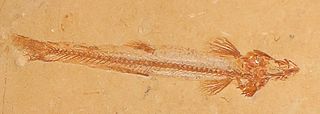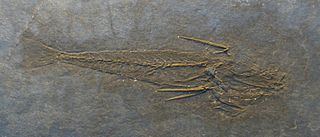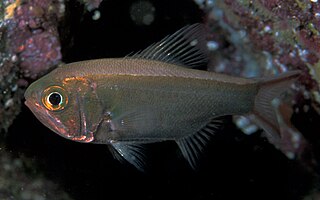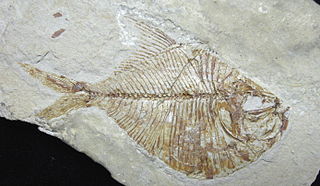
Acanthomorpha is an extraordinarily diverse taxon of teleost fishes with spiny fin rays. The clade contains about one-third of the world's modern species of vertebrates: over 14,000 species.

Aipichthys is an extinct genus of bony fish that is possibly polyphyletic. Formerly classified in the Polymixiiformes, it is now thought to be a distant relative of oarfish and opahs.
Aulopopsis is an extinct genus of prehistoric marine ray-finned fish that lived during the lower Eocene. It is considered a relative of lizardfish in the order Aulopiformes, but its exact taxonomic placement is uncertain. Some authorities place it with the Aulopidae, while others place it with the Giganturoidae.

Charitopsis is an extinct genus of prehistoric bony fish that lived during the lower Cenomanian.

Aphanepygus is an extinct genus of prehistoric marine holostean ray-finned fish that lived during the lower Cenomanian. It inhabited the former Tethys Ocean, with remains known from Lebanon and Croatia. Its exact affinities are uncertain, although it is usually recovered as a relative of the macrosemiids. However, other authorities recover it in the Ionoscopiformes.

Sedenhorstia is an extinct genus of prehistoric bony fish that lived from the Cenomanian to Campanian.
Elopopsis is an extinct genus of prehistoric bony fish that lived from the Cenomanian to Campanian.
Lusitanichthys is an extinct genus of prehistoric bony fish that lived during the Cenomanian.
Salminops is an extinct genus of prehistoric bony fish that lived during the Cenomanian known from USA and Portugal.

Eubiodectes is an extinct genus of prehistoric bony fish that lived during the Cenomanian.
Oshunia is an extinct genus of prehistoric bony fish that lived during the Albian. Fossils of the genus were found in the Romualdo Formation of the Araripe Basin, northeastern Brazil. Other authors assign a Cenomanian age to the fish.
Bobbichthys is an extinct genus of ray-finned fish that lived in what is now Chile during the Oxfordian stage of the Late Jurassic epoch.
Aphnelepis is an extinct genus of prehistoric freshwater ray-finned fish that lived during the Late Jurassic epoch. It contains a single species, A. australis, from the Talbragar River beds of New South Wales, Australia.
Africentrum is an extinct genus of prehistoric soldierfish that lived during the Upper Miocene subepoch of what is now Malta. It contains a single species, A. melitense. It has been either recovered as the sister genus to Myripristis or in a polytomy with all the other genera in the subfamily.
Opsithrissops is an extinct genus of prehistoric bony fish that lived during the Thanetian stage of the Paleocene epoch. It is a 120 centimetres (3.9 ft) fish in the family Osteoglossiformes which includes other bony-tongues such as the extant species of arowana and arapaima.

Acanthopleurus is an extinct genus of marine bony fish that lived during the early Oligocene epoch. It is thought to be a relative of modern triplespines. It is known from the Oligocene of Glarus, Switzerland.
Acrognathus is an extinct genus of prehistoric bony fish belonging to the order Aulopiformes. Although no extensive systematic analysis has been performed, it is tentatively placed with the greeneyes in the family Chlorophthalmidae, making it the oldest representative of that family.
Pleuropholis is an extinct genus of prehistoric ray-finned fish.

The Trachichthyiformes are an order of ray-finned fishes in the superorder Acanthopterygii.

Lamprimorpha is a superorder of marine ray-finned fishes, representing a basal group of the highly diverse clade Acanthomorpha. Represented today only by the order Lampriformes, recent studies have recovered other basal fossil species of the group dating as far back as the Cenomanian stage of the Late Cretaceous. Some of these fossil taxa, such as the paraphyletic genus Aipichthys, are among the oldest known fossil acanthomorphs, and overall they appear to have been a major component of the marine fish fauna at that time. Lamprimorpha is thought to be the sister group to the superorder Paracanthopterygii, which contains cod, dories, and trout-perches.








